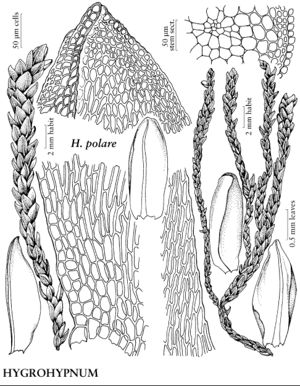Difference between revisions of "Hygrohypnum polare"
Verh. Bot. Vereins Prov. Brandenburg 46: 198. 1905.
FNA>Volume Importer |
imported>Volume Importer |
||
| (3 intermediate revisions by 2 users not shown) | |||
| Line 9: | Line 9: | ||
|special_status={{Treatment/ID/Special_status | |special_status={{Treatment/ID/Special_status | ||
|code=F | |code=F | ||
| − | |label= | + | |label=Illustrated |
}} | }} | ||
|basionyms={{Treatment/ID/Basionym | |basionyms={{Treatment/ID/Basionym | ||
|name=Hypnum polare | |name=Hypnum polare | ||
|authority=Lindberg | |authority=Lindberg | ||
| + | |rank=species | ||
|publication_title=Öfvers. Kongl. Vetensk.-Akad. Förh. | |publication_title=Öfvers. Kongl. Vetensk.-Akad. Förh. | ||
|publication_place=23: 540. 1867 | |publication_place=23: 540. 1867 | ||
| Line 20: | Line 21: | ||
|name=Calliergon polare | |name=Calliergon polare | ||
|authority=(Lindberg) Kindberg | |authority=(Lindberg) Kindberg | ||
| + | |rank=species | ||
}} {{Treatment/ID/Synonym | }} {{Treatment/ID/Synonym | ||
|name=Hygrohypnella polaris | |name=Hygrohypnella polaris | ||
|authority=(Lindberg) Ignatov & Ignatova | |authority=(Lindberg) Ignatov & Ignatova | ||
| + | |rank=species | ||
}} {{Treatment/ID/Synonym | }} {{Treatment/ID/Synonym | ||
|name=Hygrohypnum palustre var. ehlei | |name=Hygrohypnum palustre var. ehlei | ||
|authority=(Arnell) Grout | |authority=(Arnell) Grout | ||
| + | |rank=variety | ||
}} | }} | ||
|hierarchy=Amblystegiaceae;Hygrohypnum;Hygrohypnum polare | |hierarchy=Amblystegiaceae;Hygrohypnum;Hygrohypnum polare | ||
| Line 49: | Line 53: | ||
-->{{#Taxon: | -->{{#Taxon: | ||
name=Hygrohypnum polare | name=Hygrohypnum polare | ||
| − | |||
|authority=(Lindberg) Loeske | |authority=(Lindberg) Loeske | ||
|rank=species | |rank=species | ||
| Line 62: | Line 65: | ||
|publication title=Verh. Bot. Vereins Prov. Brandenburg | |publication title=Verh. Bot. Vereins Prov. Brandenburg | ||
|publication year=1905 | |publication year=1905 | ||
| − | |special status= | + | |special status=Illustrated |
| − | |source xml=https:// | + | |source xml=https://bitbucket.org/aafc-mbb/fna-data-curation/src/2e0870ddd59836b60bcf96646a41e87ea5a5943a/coarse_grained_fna_xml/V28/V28_435.xml |
|genus=Hygrohypnum | |genus=Hygrohypnum | ||
|species=Hygrohypnum polare | |species=Hygrohypnum polare | ||
Latest revision as of 21:35, 5 November 2020
Plants soft, golden yellow, yellowish green, or rarely bright green. Stems to 13 cm, not denuded basally, unbranched or irregularly branched from base; hyalodermis incomplete, as outer row of thin-walled cortical cells, evident in older stems only as thickened inner concave walls, central strand well developed. Leaves appressed-imbricate to loosely spreading, straight or falcate, appressed when dry, spreading when moist, ovate-lanceolate, oblong-lanceolate, elliptic or broadly so, shallowly to deeply concave, rarely almost plane, (0.9–)1.1–1.6(–2.1) × (0.6–)0.8–1(–1.1) mm; margins plane, sometimes slightly involute near apex, involute in falcate leaves, rendering leaf tubular distally, entire; apex tapered to acute or apiculate point, or deeply concave-cucullate with often recurved apiculus; costa single, ending just below apex or percurrent in apiculus, very stout, rarely 2-fid; alar cells many, quadrate or short-rectangular, region well defined; basal laminal cells shorter, wider than medial cells, walls incrassate, yellowing with age; medial cells fusiform to long linear-flexuose, (33–)40–50(–65) × 5–6(–8) µm; apical cells shorter, usually rhomboid; marginal cells somewhat shorter. Sexual condition dioicous; perichaetial inner leaves long-lanceolate, plicate, apex gradually tapering, frayed with age, costa single. Seta yellow-brown, 1–1.2 cm. Capsule with peristome unknown.
Habitat: Acidic rock in montane or high latitude streams
Elevation: moderate elevations (900-1400 m)
Distribution

Greenland, B.C., Nfld. and Labr. (Labr.), Nunavut, Yukon, Alaska, Europe, Asia.
Discussion
Hygrohypnum polare is easily recognized by its strong, single costa and outer layer of thin-walled cortical cells in the stem. The quadrate alar cells and the usual leaf concavity provide confirmation. The plants grow in appressed turfs or loose patches that may be prostrate, ascending, or erect; the branches are usually fastigiate; and the alar cells have thin hyaline walls that become brown with age.
Selected References
None.
